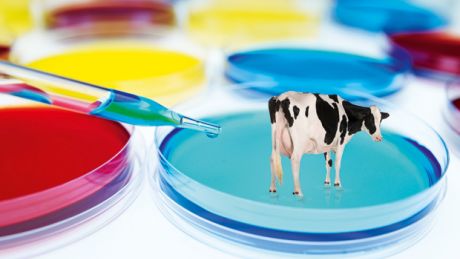Lab-grown meat: is it the future?
On 5th August, the first lab-created burger was unveiled. In MF June 2013, Mark Bailey looked at the science behind artificially grown meat

In This Series
- Lab-grown meat: is it the future?
- Lab-grown meat: is it the future?
- Lab-grown meat: is it the future?
Picture the perfect steak. The plump mahogany and claret-coloured flesh on your plate. The soft bounce when your fork punctures its tender surface. That delicious alchemy of muscle, fat and juice that electrifies every last molecule of your caveman DNA.
Yes, man loves meat. But would this image be so tantalising if your steak had been grown in a lab using a nutrient-rich broth and a bioreactor? Or synthesised, dot by dot, by a 3D printer using cartridges filled with live cells? Would this enhance your ethical enjoyment of meat or neutralise its primal appeal? Would you marvel at your futuristic steak’s cleverly optimised health properties or fear what you chewed? These are questions we may soon need to ask ourselves.
High steaks
Escalating costs, a colossal environmental footprint and a rising global population make today’s meat-producing infrastructure unsustainable, leaving experts hunting for solutions. ‘We cannot carry on eating meat in the future like we did in the past,’ says Brian J Ford, a biologist and author of Meat: The Story Behind Our Greatest Addiction. ‘The whole system must be completely restructured.’
So why might we be condemned to a grim life without chicken tikka masala and bacon double cheeseburgers? Because we’re effectively living a lie. ‘When we think of the “cost” of meat we see a price on a label, but this isn’t realistic,’ says Isha Datar, executive director of New Harvest, an organisation that researches alternative methods of meat production. ‘Without agricultural subsidies, meat would be unaffordable.’
Livestock grazing now takes up 26% of the Earth’s ice-free surface and 33% of agricultural land is used to produce livestock feed. According to the UN Food and Agriculture Organisation, the global population of seven billion people eat 278 million tonnes of meat a year. By 2050, the population will reach nine billion and demand will hit 460 million tonnes. At present, 56 billion land animals are slaughtered for food each year. That’s 1,774 a second. Blink. That’s another 1,774 gone. Every five minutes, half a million creatures are turned into dinner.
Andras Forgacs, co-founder of Modern Meadow, which is researching the possibility of 3D printed meat, says each hamburger is ‘an environmental train wreck’. The livestock industry generates 9% of anthropogenic (human-related) carbon dioxide emissions, 65% of nitrous oxide emissions and 37% of methane emissions. ‘Livestock production accounts for 18% of greenhouse gas emissions worldwide – that’s more than all planes, trains and cars,’ says Datar.
Nor is the system efficient. It takes 7kg of grain (as feed) to produce 1kg of beef and about 40% of the world’s grain is fed to animals. ‘Three calories of energy are required to produce one calorie of food energy from a plant source, but it takes 35 calories of energy to produce one calorie of energy from beef.’
In the flesh
To prevent us all turning into glum vegetarians holding candlelit vigils outside derelict branches of Nando’s, scientists have been perfecting the art of cultured meat. In 2000, Nasa-funded scientists at Touro College in New York grew muscle cells taken from the abdomen of a carassius auratus (that’s a goldfish to you and me). According to bioengineer Morris Benjaminson, they ‘smelled just like fish fillets’ when cooked – although strict regulations mean cultured flesh has yet to be officially taste-tested. A Dutch research team has been creating strands of cultured pork since 2006 and in 2011 Mark Post, a vascular biologist at the University of Maastricht, announced plans to create the world’s first lab-made hamburger.
To make cultured meat, embryonic stem cells are taken from an animal then enriched in a ‘broth’ of sugars, amino acids, lipids, minerals and nutrients (a substitute for blood). They’re then attached to a scaffold structure and placed in a bioreactor to grow into muscle over several weeks.
To create appropriate texture, the muscle must be ‘exercised’ as if it were part of a living animal. This happens by stretching the muscle, stimulating it with electrical impulses or introducing polysaccharide beads that expand and contract to give the tissue a workout. The muscle tissue is then harvested and presented as a processed meat. According to New Harvest, cultured meat in sausage, nugget or burger form could be produced ‘within a few years’, although full steaks may take a decade to develop.
Get the Coach Newsletter
Sign up for workout ideas, training advice, reviews of the latest gear and more.
Mark Bailey is a features writer and interviewer who contributed to Coach magazine in 2015 and Men’s Fitness UK, which predated, and then shared a website with, Coach, until 2019. Mark has also written for national newspapers including The Telegraph and The Financial Times Magazine, as well as magazines and websites such as Cyclist and Bike Radar.
